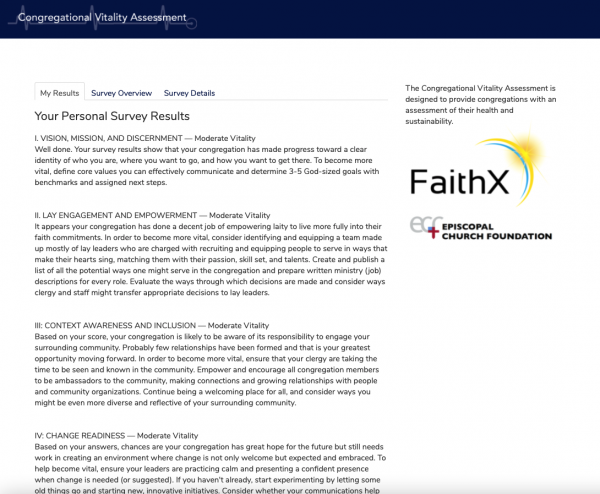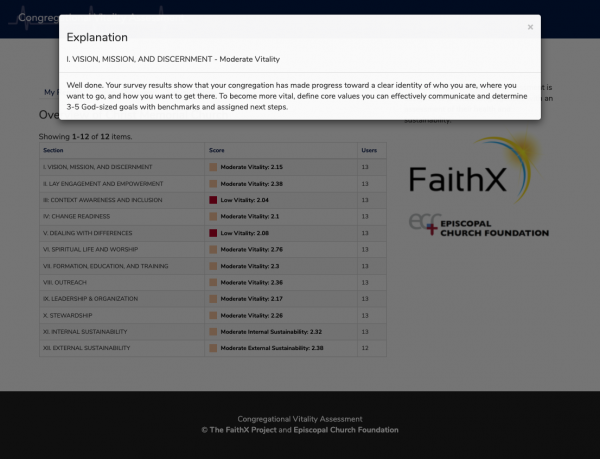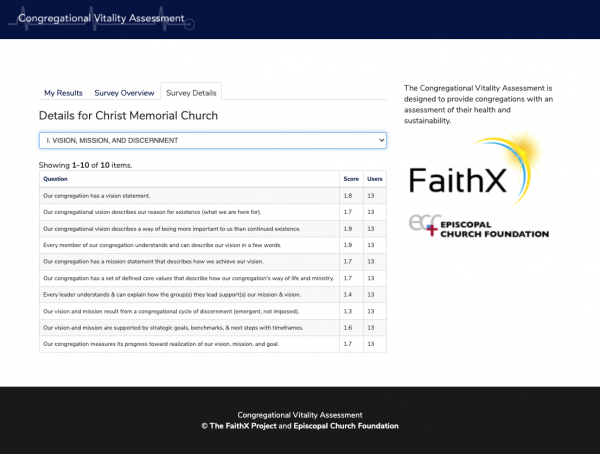CVA FAQs

Frequently Asked Questions (FAQs)
Click on the questions below to reveal responses.
Question not answered – click here to submit yours
Single Congregation Users
The Congregational Vitality Assessment is designed to help a congregation: The CVA measures how effectively a congregation is carrying out 11 vital areas of congregational functioning:
The CVA measures two important aspects of congregational functioning:
To get the most benefit for your congregation from the CVA, follow these suggested best practices: Designate an Assessment Initiator It will be important to designate a single individual to be the CVA initiator. This person will: For congregations with over 50 active members we recommend a representative sample of no more than 25 people (i.e., NOT the entire congregation). In most cases a sample of 15 people is perfectly adequate as long as it is a representative subset of the makeup of the congregation. For Congregations with fewer than 50 active members. Obviously, it is never a good idea to give something to half the congregation and leave the other half out. In such a case, congregation wide implementation is recommended, but leadership may need to interpret the results in light of the biases this might produce. What do we mean by a representative sample. By a representative sample we mean representative of both the leadership structure of church and its demographic make up. In other words, a group that captures the full diversity of your congregation, including but not limited to: To determine what your representative sample should look like: There are several reasons we recommend this: Invite, Don’t Advertise Once you have determined what a representative group should look like, select individuals that represent the various groups you have identified, and personally/individually invite them. Explain how the results can benefit the congregation. Ask them more than once if necessary. Start with the congregation’s governing board, supplement them with ministry chairs, then fill in the holes with congregation members. Explain to each person why their input is important. Remind, Remind, Remind Inform the participants that they will have until 14 days after the CVA was initiated (provide the exact date) to complete the assessment, and that on the 15th day you will receive the results. Remind the those who will be taking the CVA at several points during the 14-day assessment period: Share the Results Share the CVA results with the congregation in concentric circles, working outward: Pro-Tip: Put the results in a spreadsheet and create a barchart, then: Discern how God is speaking to you through the data Yes, data can play an important role in congregational discernment, by helping you look into your blind spots and overcome your unconscious biases. Pro-Tip: For best discernment results, request a Neighborhood Insights Report (from FaithX), then: Need help in interpreting and reflecting on any of the above? Contact FaithX at [email protected] 20-30 minutes max. If you take longer than that, you are thinking too long and hard about the answers. Do not overthink – respond quickly and move on. If you don't know or are not confident about a certain answer, elect your best impression. It is valuable to know what a respondent's perception is. In the end we are measuring many things, including the perceptions from several viewpoints. Prescriptive professional analysis tools for congregational life have been around in many forms for a while, and offer congregations concrete ways to view their mission, ministry, and corporate life together. However, no other vitality assessment tool to date is as thoroughly grounded in research and data, and most come with high price tags that are cost prohibitive for many communities of faith to use.
FaithX and ECF view congregational vitality to be the paramount issue for faith communities today. Yet those congregations that most need help addressing their vitality issues often can least afford it. Free access to the CVA is one way we are trying to address that need. There are no strings attached. Of course, since both FaithX and ECF offer consultative services, we hope you will keep us in mind if you them. FaithX will offer a 10% discount on services to any congregation that has taken the CVA.
Questions: The CVA asks the user to answer 5-10 question in each of 13 areas of congregational life: 11 focused on vitality and 2 on sustainability. Single Church Version: When the individual or team has completed the CVA, the answers are scored, and the individual or team leader then receives summary scores of each of the ten vitality areas and two sustainability areas, along with suggestions of ways to improve in each of the areas.
Judicatory Version: Detailed spreadsheet reports are available for download. These reports show vitality scores from all congregations and organizations within the Judicatory, answer distribution for each question by congregation, and a report of complete responses.
Click on the images below for a more detailed look.
CVA diagnostic ratings are based on a criterion-referenced (not on a curve) 1-4 scale:
All CVA questions are grounded in research, and research suggests that using an endowment to underwrite operating expenses (including ongoing outreach) negatively affects individual and congregational stewardship over the long term. Endowments aren’t forever. That means that congregations that grow dependent on them are much more likely drive off the proverbial cliff when the money runs out.
There are several things a congregation can do after taking the CVA. These include:
The above process is what we call a Missional Assessment. You can do it yourselves or you can engage FaithX to lead you through it (we meet with your congregational leader in four sessions over a 6-8 week period to guide you through the process).
Contact us at [email protected] for more information. The CVA is updated at the end of any year in which vitality-related research is newly released or user feedback results in changes. For example, user feedback as so far led to:
Step 1 – Research: The CVA was based on 20 years of research from a variety of sources (click here) and will be refined as new research emerges.
Step 2 – Iterative Prototyping: CVA 1.0 (excel-based version) was the result of 10 years of iterative prototyping, using data and feedback gathered from hundreds of congregations representing a cross-section of race, ethnicity, and denomination.
Step 3 – Beta-Testing: CVA 1.1 (first online version) gathered data and feedback from hundreds of congregations across a similar cross section.
Step 4 – Soft Launch: CVA 2.0 (second online version) included a number of enhancements based on feedback from users of CVA 1.1, including a redesigned user interface and ethnically-sensitive language and terminology.
Step 5 – Ongoing Updates and Enhancements: based on user feedback and emerging research.
Absolutely. People of color were involved throughout the design, prototyping, and beta testing of the CVA. In addition, the FaithX Board of Directors, of which nearly half are people of color, continue to provide feedback for ongoing improvements in the CVA.
A CVA Spanish version of the CVA will be included in version 2.1, to be released before the end of 2021, if not sooner. We had hoped to have it in 2.0 and were almost there but ran out of time to do the final QC checks.
What is the purpose of the Congregational Vitality Assessment (or CVA)?
What is the difference between a congregation’s Vitality and its Sustainability?
What elements of Vitality does the CVA measure?
What elements of Sustainability does the CVA measure?
Best Practices: How is the CVA best administered?
How long should it take for the average person to complete the CVA?
What if I don't know the answer to a question?
What makes the CVA unique?
Why are FaithX and ECF making the CVA available free? Are there any strings attached?
What kind of questions does the CVA ask?
What do CVA results look like?
How should we interpret the section scores for our congregation(s)?
Why does the CVA rate congregations lower that have an endowment and use it for operating expenses?
What should our congregation do after taking the CVA?
What are research sources on which the CVA is grounded?
How often is the CVA updated based on new research and user feedback?
What is the process by which the CVA was developed?
Were any people of color involved in the development of the CVA?
When will a Spanish version of the CVA be released?
Congregational Vitality Assessment Judicatory Dashboard
The CVA and the Judicatory Platform are two different but complementary tools:
The CVA Judicatory Platform was developed in response to the requests of several judicatories. To get the most benefit for your judicatory and its congregations, follow these suggested best practices. Designate a CVA-Judicatory Platform Judicatory-Level Coordinator It will be important to designate a judicatory staff person to coordinate with congregations in initiating, administering, and interpreting the CVA. This person will: CVA-Judicatory Platform Roll Out DO: DO NOT: Invite, Don’t Advertise Once you have determined the order in which the congregations will be exposed to the CVA personally/individually invite congregational leadership to participate. Explain how the results can benefit the congregation. Ask them more than once if you have to. Remind, Remind, Remind When implementing the CVA in a congregation, ask the congregational coordinator to Inform participants that they will have until 14 days after the CVA was initiated (provide the exact date) to complete the assessment, and that on the 15th day they will receive the results. Similarly, ask the congregational CVA coordinator to remind the those who will be taking the CVA at several points during the 14-day assessment period: Share the Results Work with the CVA coordinator and congregational leadership to share the CVA results with the congregation in concentric circles, working outward: Pro-Tip: Put the results in a spreadsheet and create a barchart, then: Discern how God is speaking to you through the data Yes, data can play an important role in congregational discernment, by helping you look into your blind spots and overcome your unconscious biases. Pro-Tip: For best discernment results, request a Neighborhood Insights Report from FaithX (or if you have MapDash for Faith Communities, produce one for the congregation) then help them: Need help in interpreting and reflecting on any of the above or want to learn about MapDash? Contact FaithX at [email protected] The CVA Judicatory Platform allows for 10 unscored judicatory-specific questions to be added to the CVA for congregations to answer. Available question formats include: Questions are submitted using a spreadsheet we provide, which include several pre-vetted questions from which you can choose. Or you may create your own. *We recommend limiting the number of short answer questions because they lengthen the time it takes both for the participant to complete the survey and for the CVA Judicatory Coordinator to tabulate it.How is the CVA Judicatory Platform different from the Congregational Vitality Assessment?
How does the Judicatory Platform work?
Best Practices – How do we get the most benefit for our judicatory from using the CVA Judicatory Platform?
Custom Questions – How many can we have? What kinds can we have?







